2016 HYUNDAI IX35 engine
[x] Cancel search: enginePage 537 of 550
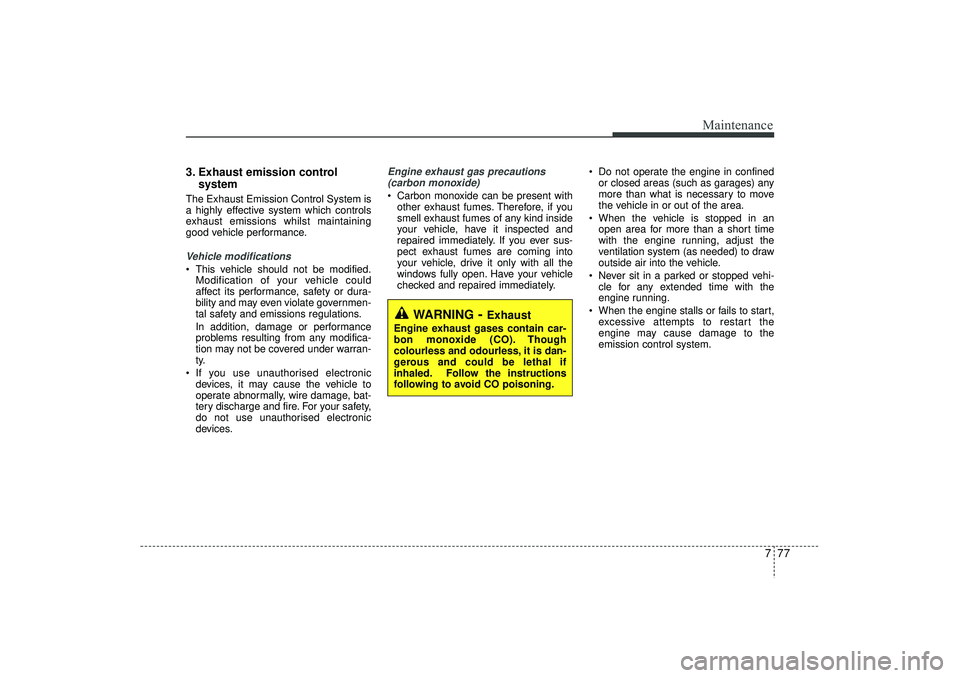
777
Maintenance
3. Exhaust emission control systemThe Exhaust Emission Control System is
a highly effective system which controls
exhaust emissions whilst maintaining
good vehicle performance.Vehicle modifications This vehicle should not be modified.
Modification of your vehicle could
affect its performance, safety or dura-
bility and may even violate governmen-
tal safety and emissions regulations.
In addition, damage or performance
problems resulting from any modifica-
tion may not be covered under warran-
ty.
If you use unauthorised electronic devices, it may cause the vehicle to
operate abnormally, wire damage, bat-
tery discharge and fire. For your safety,
do not use unauthorised electronic
devices.
Engine exhaust gas precautions (carbon monoxide) Carbon monoxide can be present with other exhaust fumes. Therefore, if you
smell exhaust fumes of any kind inside
your vehicle, have it inspected and
repaired immediately. If you ever sus-
pect exhaust fumes are coming into
your vehicle, drive it only with all the
windows fully open. Have your vehicle
checked and repaired immediately. Do not operate the engine in confined
or closed areas (such as garages) any
more than what is necessary to move
the vehicle in or out of the area.
When the vehicle is stopped in an open area for more than a short time
with the engine running, adjust the
ventilation system (as needed) to draw
outside air into the vehicle.
Never sit in a parked or stopped vehi- cle for any extended time with the
engine running.
When the engine stalls or fails to start, excessive attempts to restart the
engine may cause damage to the
emission control system.
WARNING
- Exhaust
Engine exhaust gases contain car-
bon monoxide (CO). Though
colourless and odourless, it is dan-
gerous and could be lethal if
inhaled. Follow the instructions
following to avoid CO poisoning.
EL(FL) UK 7.QXP 3/4/2015 9:08 PM Page 77
Page 538 of 550
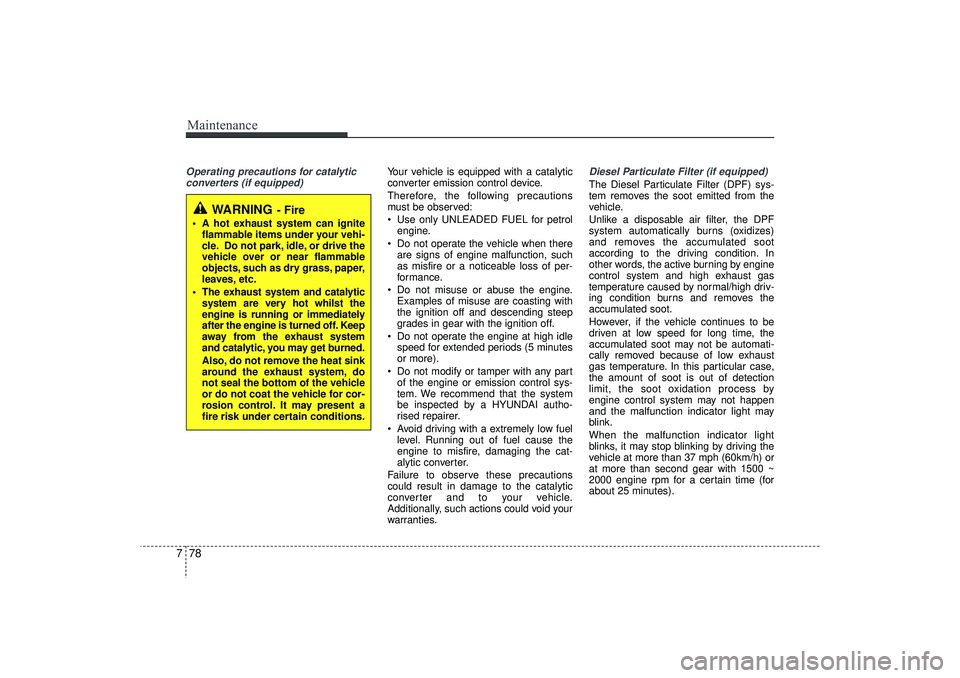
Maintenance78
7Operating precautions for catalytic
converters (if equipped)
Your vehicle is equipped with a catalytic
converter emission control device.
Therefore, the following precautions
must be observed:
Use only UNLEADED FUEL for petrol engine.
Do not operate the vehicle when there are signs of engine malfunction, such
as misfire or a noticeable loss of per-
formance.
Do not misuse or abuse the engine. Examples of misuse are coasting with
the ignition off and descending steep
grades in gear with the ignition off.
Do not operate the engine at high idle speed for extended periods (5 minutes
or more).
Do not modify or tamper with any part of the engine or emission control sys-
tem. We recommend that the system
be inspected by a HYUNDAI autho-
rised repairer.
Avoid driving with a extremely low fuel level. Running out of fuel cause the
engine to misfire, damaging the cat-
alytic converter.
Failure to observe these precautions
could result in damage to the catalytic
converter and to your vehicle.
Additionally, such actions could void your
warranties.
Diesel Particulate Filter (if equipped)The Diesel Particulate Filter (DPF) sys-
tem removes the soot emitted from the
vehicle.
Unlike a disposable air filter, the DPF
system automatically burns (oxidizes)
and removes the accumulated soot
according to the driving condition. In
other words, the active burning by engine
control system and high exhaust gas
temperature caused by normal/high driv-
ing condition burns and removes the
accumulated soot.
However, if the vehicle continues to be
driven at low speed for long time, the
accumulated soot may not be automati-
cally removed because of low exhaust
gas temperature. In this particular case,
the amount of soot is out of detection
limit, the soot oxidation process by
engine control system may not happen
and the malfunction indicator light may
blink.
When the malfunction indicator light
blinks, it may stop blinking by driving the
vehicle at more than 37 mph (60km/h) or
at more than second gear with 1500 ~
2000 engine rpm for a certain time (for
about 25 minutes).
WARNING
- Fire
A hot exhaust system can ignite flammable items under your vehi-
cle. Do not park, idle, or drive the
vehicle over or near flammable
objects, such as dry grass, paper,
leaves, etc.
The exhaust system and catalytic system are very hot whilst the
engine is running or immediately
after the engine is turned off. Keep
away from the exhaust system
and catalytic, you may get burned.
Also, do not remove the heat sink
around the exhaust system, do
not seal the bottom of the vehicle
or do not coat the vehicle for cor-
rosion control. It may present a
fire risk under certain conditions.
EL(FL) UK 7.QXP 3/4/2015 9:08 PM Page 78
Page 540 of 550
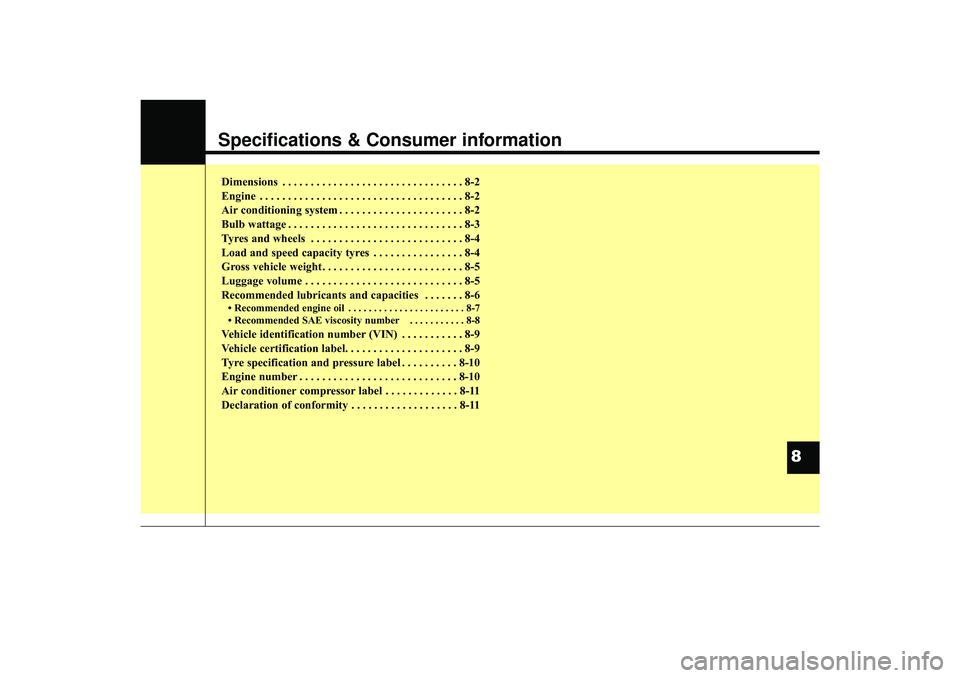
Specifications & Consumer informationDimensions . . . . . . . . . . . . . . . . . . . . . . . . . . . . . . . . 8-2
Engine . . . . . . . . . . . . . . . . . . . . . . . . . . . . . . . . . . . . \
8-2
Air conditioning system . . . . . . . . . . . . . . . . . . . . . . 8-2
Bulb wattage . . . . . . . . . . . . . . . . . . . . . . . . . . . . . . . 8-3
Tyres and wheels . . . . . . . . . . . . . . . . . . . . . . . . . . . 8-4
Load and speed capacity tyres . . . . . . . . . . . . . . . . 8-4
Gross vehicle weight. . . . . . . . . . . . . . . . . . . . . . . . . 8-5
Luggage volume . . . . . . . . . . . . . . . . . . . . . . . . . . . . 8-5
Recommended lubricants and capacities . . . . . . . 8-6• Recommended engine oil . . . . . . . . . . . . . . . . . . . . . . . 8-7
• Recommended SAE viscosity number . . . . . . . . . . . 8-8Vehicle identification number (VIN) . . . . . . . . . . . 8-9
Vehicle certification label. . . . . . . . . . . . . . . . . . . . . 8-9
Tyre specification and pressure label . . . . . . . . . . 8-10
Engine number . . . . . . . . . . . . . . . . . . . . . . . . . . . . 8-10
Air conditioner compressor label . . . . . . . . . . . . . 8-11
Declaration of conformity . . . . . . . . . . . . . . . . . . . 8-11
8
EL(FL) UK 8.QXP 3/13/2015 5:44 PM Page 1
Page 541 of 550
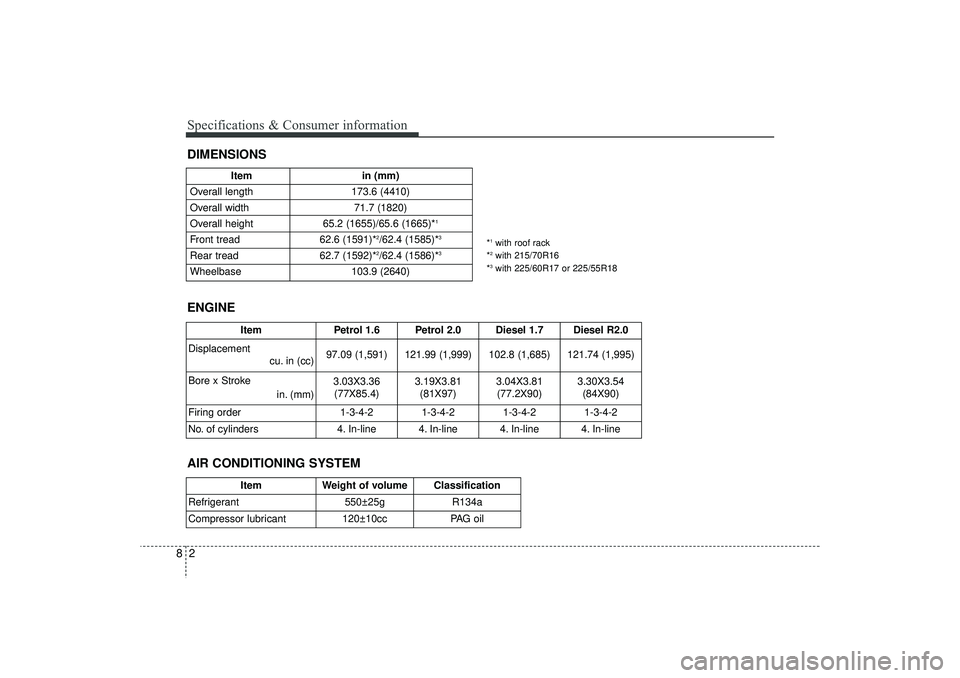
Specifications & Consumer information28DIMENSIONS
Itemin (mm)
Overall length 173.6 (4410)
Overall width 71.7 (1820)
Overall height 65.2 (1655)/65.6 (1665)*
1
Front tread62.6 (1591)*
2/62.4 (1585)*
3
Rear tread62.7 (1592)*
2/62.4 (1586)*
3
Wheelbase 103.9 (2640)
*1with roof rack
*2with 215/70R16
*3with 225/60R17 or 225/55R18
ENGINE
Item
Petrol 1.6 Petrol 2.0
Diesel 1.7
Diesel R2.0
Displacement cu. in (cc)
97.09 (1,591) 121.99 (1,999)
102.8 (1,685)
121.74 (1,995)
Bore x Stroke in. (mm)
3.03X3.36(77X85.4) 3.19X3.81
(81X97)
3.04X3.81(77.2X90)
3.30X3.54 (84X90)
Firing order
1-3-4-2 1-3-4-2
1-3-4-2
1-3-4-2
No. of cylinders
4. In-line 4. In-line
4. In-line
4. In-line
Item
Weight of volume Classification
Refrigerant
550±25g R134a
Compressor lubricant120±10cc PAG oil
AIR CONDITIONING SYSTEM
EL(FL) UK 8.QXP 3/13/2015 5:44 PM Page 2
Page 545 of 550
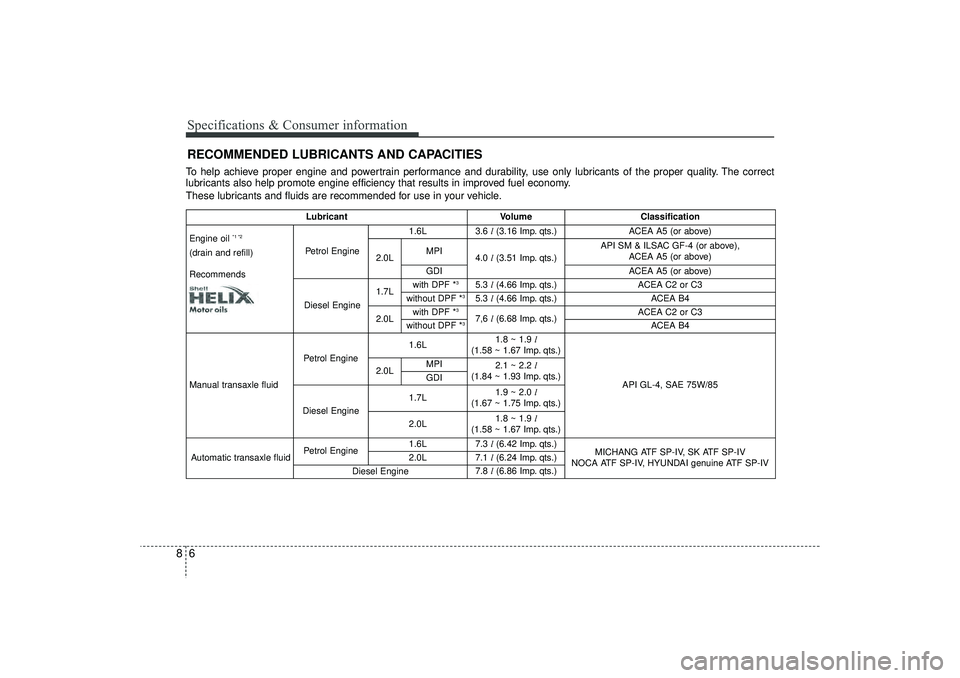
Specifications & Consumer information68To help achieve proper engine and powertrain performance and durability, use only lubricants of the proper quality. The correct
lubricants also help promote engine efficiency that results in improved fuel economy.
These lubricants and fluids are recommended for use in your vehicle.RECOMMENDED LUBRICANTS AND CAPACITIES
Lubricant
Volume
Classification
Engine oil
*1 *2
(drain and refill)
Recommends
Petrol Engine
1.6L
3.6 l(3.16 Imp. qts.)
ACEA A5 (or above)
2.0L
MPI
4.0 l(3.51 Imp. qts.)
API SM & ILSAC GF-4 (or above),
ACEA A5 (or above)
GDI
ACEA A5 (or above)
Diesel Engine
1.7L
with DPF *
3
5.3 l(4.66 Imp. qts.)
ACEA C2 or C3
without DPF *
3
5.3 l(4.66 Imp. qts.)
ACEA B4
2.0L
with DPF *
3
7,6 l(6.68 Imp. qts.)
ACEA C2 or C3
without DPF *
3
ACEA B4
Manual transaxle fluid
Petrol Engine
1.6L
1.8 ~ 1.9 l
(1.58 ~ 1.67 Imp. qts.)
API GL-4, SAE 75W/85
2.0L
MPI
2.1 ~ 2.2 l
(1.84 ~ 1.93 Imp. qts.)
GDI
Diesel Engine
1.7L
1.9 ~ 2.0 l
(1.67 ~ 1.75 Imp. qts.)
2.0L
1.8 ~ 1.9 l
(1.58 ~ 1.67 Imp. qts.)
Automatic transaxle fluid
Petrol Engine
1.6L
7.3 l(6.42 Imp. qts.)
MICHANG ATF SP-IV, SK ATF SP-IV
NOCA ATF SP-IV, HYUNDAI genuine ATF SP-IV
2.0L
7.1 l(6.24 Imp. qts.)
Diesel Engine
7.8 l(6.86 Imp. qts.)
EL(FL) UK 8.QXP 3/13/2015 5:44 PM Page 6
Page 546 of 550
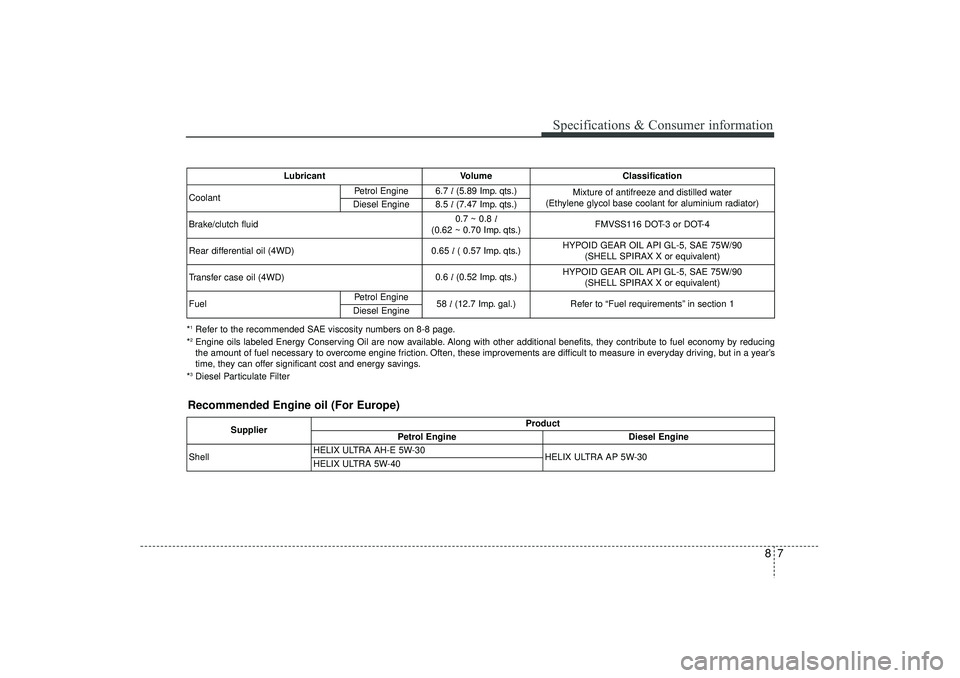
87
Specifications & Consumer information
LubricantVolume Classification
Coolant
Petrol Engine
6.7 l(5.89 Imp. qts.)
Mixture of antifreeze and distilled water
(Ethylene glycol base coolant for aluminium radiator)
Diesel Engine
8.5 l(7.47 Imp. qts.)
Brake/clutch fluid
0.7 ~ 0.8 l
(0.62 ~ 0.70 Imp. qts.)
FMVSS116 DOT-3 or DOT-4
Rear differential oil (4WD) 0.65
l( 0.57 Imp. qts.) HYPOID GEAR OIL API GL-5, SAE 75W/90
(SHELL SPIRAX X or equivalent)
Transfer case oil (4WD) 0.6
l(0.52 Imp. qts.) HYPOID GEAR OIL API GL-5, SAE 75W/90
(SHELL SPIRAX X or equivalent)
Fuel Petrol Engine
58 l(12.7 Imp. gal.)
Refer to “Fuel requirements” in section 1
Diesel Engine
Recommended Engine oil (For Europe)
Supplier Product
Petrol Engine Diesel Engine
Shell HELIX ULTRA AH-E 5W-30
HELIX ULTRA AP 5W-30
HELIX ULTRA 5W-40
*1Refer to the recommended SAE viscosity numbers on 8-8 page.
*2Engine oils labeled Energy Conserving Oil are now available. Along with other additional benefits, they contribute to fuel economy by reducing
the amount of fuel necessary to overcome engine friction. Often, these improvements are difficult to measure in everyday driving, but in a year’s
time, they can offer significant cost and energy savings.
*3Diesel Particulate Filter
EL(FL) UK 8.QXP 3/13/2015 5:44 PM Page 7
Page 547 of 550
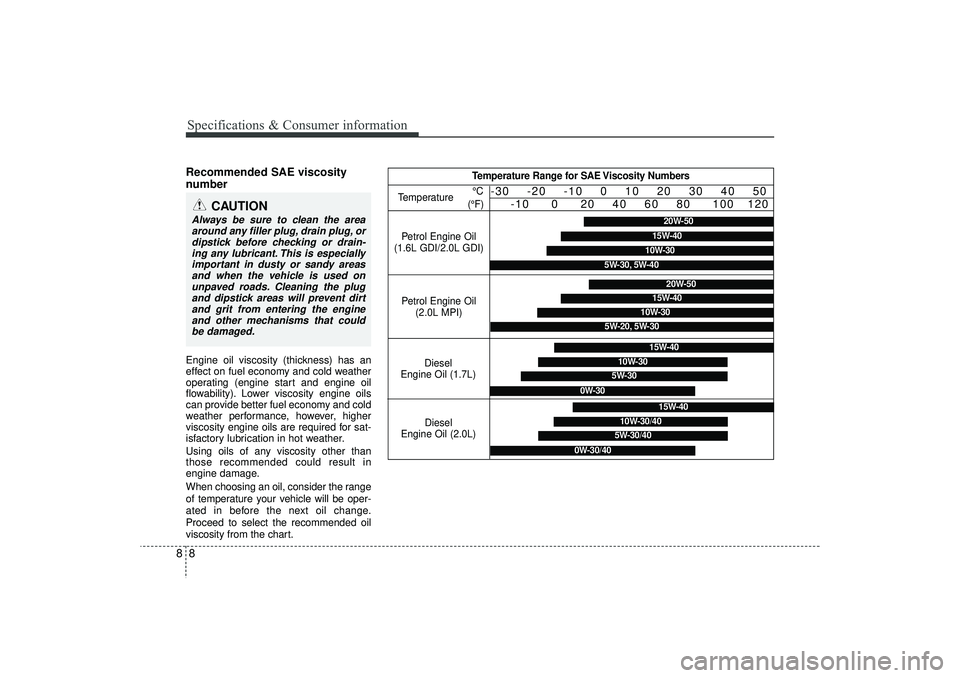
Specifications & Consumer information88Recommended SAE viscosity
number Engine oil viscosity (thickness) has an
effect on fuel economy and cold weather
operating (engine start and engine oil
flowability). Lower viscosity engine oils
can provide better fuel economy and cold
weather performance, however, higher
viscosity engine oils are required for sat-
isfactory lubrication in hot weather.
Using oils of any viscosity other than
those recommended could result in
engine damage.
When choosing an oil, consider the range
of temperature your vehicle will be oper-
ated in before the next oil change.
Proceed to select the recommended oil
viscosity from the chart.
CAUTION
Always be sure to clean the areaaround any filler plug, drain plug, or dipstick before checking or drain-ing any lubricant. This is especiallyimportant in dusty or sandy areas and when the vehicle is used onunpaved roads. Cleaning the plugand dipstick areas will prevent dirtand grit from entering the engine and other mechanisms that couldbe damaged.
Temperature Range for SAE Viscosity Numbers
Temperature °C
(°F)
-30 -20 -10 0 10 20 30 40 50 -10 0 20 40 60 80 100 120
Diesel
Engine Oil (1.7L)
5W-30
15W-40
10W-30
0W-30
Diesel
Engine Oil (2.0L)
5W-30/40
15W-40
10W-30/40
0W-30/40
Petrol Engine Oil
(1.6L GDI/2.0L GDI)
20W-50
10W-3015W-40
5W-30, 5W-40
Petrol Engine Oil (2.0L MPI)
20W-50
15W-40
10W-30
5W-20, 5W-30
EL(FL) UK 8.QXP 3/13/2015 5:44 PM Page 8
Page 549 of 550
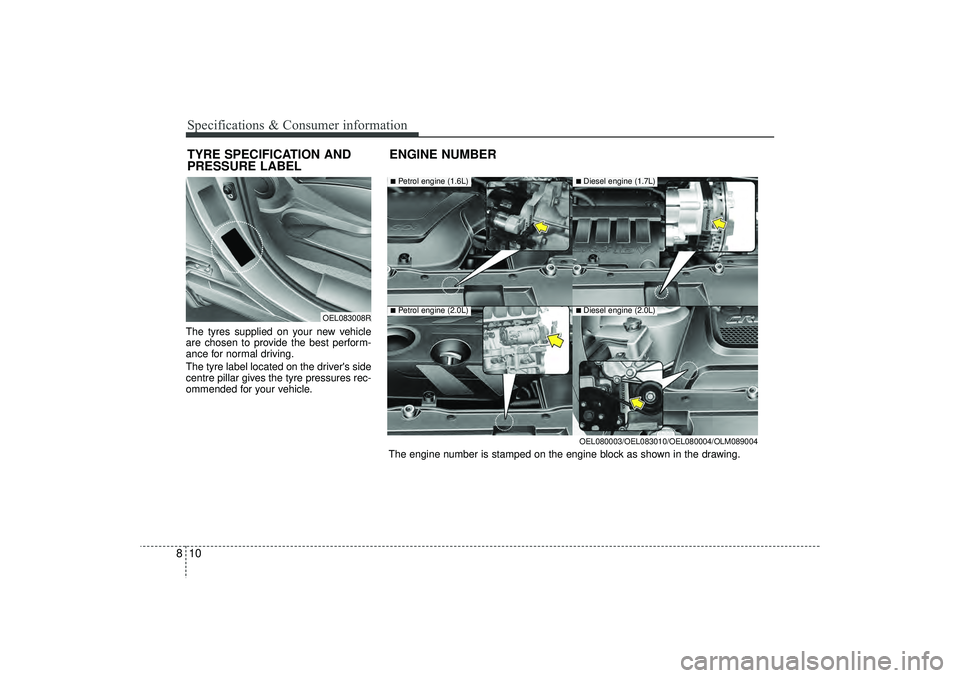
Specifications & Consumer information10
8The tyres supplied on your new vehicle
are chosen to provide the best perform-
ance for normal driving.
The tyre label located on the driver's side
centre pillar gives the tyre pressures rec-
ommended for your vehicle.TYRE SPECIFICATION AND
PRESSURE LABEL ENGINE NUMBER
The engine number is stamped on the engine block as shown in the drawing.
OEL083008R
■Petrol engine (1.6L)■Petrol engine (2.0L)
■Diesel engine (1.7L)■Diesel engine (2.0L)OEL080003/OEL083010/OEL080004/OLM089004
EL(FL) UK 8.QXP 3/13/2015 5:44 PM Page 10